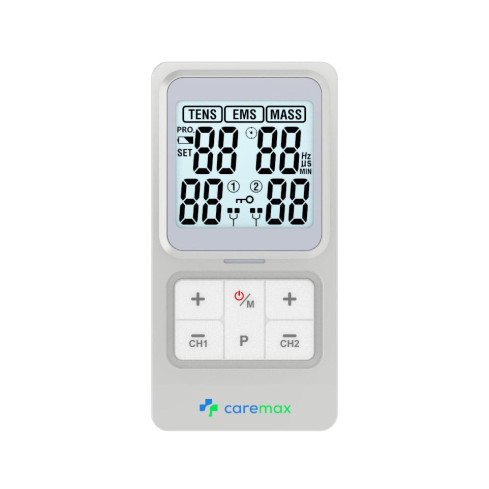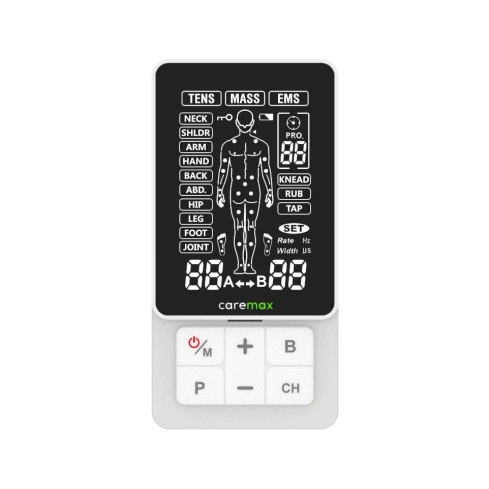Product added to cart
- Home
- TENS & EMS
- Using EMS machine for Weight Loss
Introduction
Recently, there has been growing interest in exploring innovative approaches to enhance weight loss and body composition management. Electrical muscle stimulation (EMS) devices deliver electrical impulses to activate muscles and induce contractions. In combination with healthy lifestyle practices, EMS has the potential to increase weight loss and maintain lean muscle mass. This guide will go through how to use electrical muscle stimulation for weight loss and essential background information.
Weight and Health
Maintaining a healthy weight is crucial for overall health, including longevity, fitness, and mental wellbeing. In particular, being overweight or obese can increase the risk of chronic diseases such as heart disease, diabetes, and certain cancers [1]. Carrying too much weight also puts more strain on the body and affects a person’s ability to move efficiently. These physical benefits also influence mental health by improving confidence and the release of ‘feel-good’ hormones (i.e., dopamine, etc.). Overall, effective weight management is essential for many aspects of health, including quality of life, cardiovascular health, and sustaining a long, healthy life.
Common Healthy Ways to Lose Weight Fast
Losing weight in a sustainable and safe manner is crucial for achieving long-term health and wellness. There are many ways to lose fat, but they can also lead to a lot of drawbacks, including muscle loss, hormonal disruption, and poor mood. Each person has their own needs and goals, so there isn’t one single weight-loss approach that suits everyone.
However, the key to losing weight is being in a ‘calorie deficit’ [2]. Where the body is burning more calories than it consumes. There are three ways to achieve a ‘calorie deficit: 1) reduce the calories being eaten, 2) increase the calories being burned, or 3) do both. Having a healthy lifestyle that comprises eating a healthy diet, exercising, and moving more is pivotal for losing weight. While not always the fastest, these are the most reliable practices for healthy weight loss.
What is an EMS machine, and how can it help weight loss?
An electrical muscle stimulation (EMS) machine is a medical device that delivers electrical impulses through the skin, which cause contractions of the underlying muscle. This can feel like the muscles are twitching or tensing. It is used in a variety of settings, such as fitness, rehabilitation, and physiotherapy. EMS machines have also been used to help with weight loss through several means, including [3]:
- Muscle activation over specific muscle groups leads to energy and calories being burned.
- improving the metabolic rate of treated muscle groups.
- Increase blood circulation and nutrient delivery to your muscles.
What's the best way to use an EMS machine for weight loss?
While more research [4] is still emerging about the best practices for EMS machines for weight loss, it’s important to consider the location and settings. These factors will be discussed in the sections below. Although EMS machines can assist with weight loss, they are most effective when combined with healthy practices such as exercise and nutrition. If you’re unsure, speak to a relevant healthcare practitioner about using an EMS machine for weight loss.
Here are the best practises for using an EMS unit:
-
Position of electrode pads for weight loss
The position of the electrode pads will depend on the area that you’re targeting for weight loss. Only areas that are treated may experience weight loss benefits. For instance, if the weight loss goal is to get a six-pack, the electrode pads are placed around the stomach. A chart of the electrode placement for specific areas of the body will be packaged along with the device.
-
Setting the EMS mode for weight loss
There are several settings that need to be considered for effective EMS use of weights. Parameters that can be adjusted include frequency (Hz), pulse width, and intensity (mA). While both frequency and pulse width can be set beforehand, intensity is adjusted during the session. The intensity needs to be adjusted so that the user can feel a contraction and twitch in the targeted muscle group(s). However, the treatment needs to be well tolerated by the user. Researchers encourage about a 5-7/10 intensity, which can be described as a ‘hard’ to ‘very hard’ sensation [4].
-
Setting the pulse rate (frequency) for weight loss
Currently, there is no consensus about the best frequency for weight loss. Researchers [4] have recommended using a high frequency of 80–100 Hz to assist with weight loss and body composition.
-
Setting the pulse width for weight loss
Similar to pulse rate, there is no consensus for the most effective pulse width setting. However, researchers have used 350-400s during EMS treatment to assist with weight loss and body composition [4].
-
How Often Should You Use Your EMS Machine for Weight Loss?
Further research [3][4] needs to be conducted to confirm EMS machine usage for weight loss. Studies have used treatment sessions ranging from 10–45 minutes over 1–5 sessions a week to assist with weight loss. However, an EMS machine is most effective when used in conjunction with dietary changes (i.e., increased protein intake, reduced calorie intake, etc.).
Using Caremax EMS machine for Weight Mangement
We provide a comprehensive packaging solution for weight management. Discover the most sought-after products below essential for effective EMS therapy treatment.
 |
 |
| Caremax 2.0 Classic EMS machine | Caremax 2.0 Pro EMS Machine |
Other Weight Loss Strategies at Home
As noted, EMS treatment is more optimal for weight loss with other strategies, including:
- Dietary changes (i.e., increased protein intake, reduced calories, etc.)
- Increased daily physical activity
- Regular exercise (i.e., aerobic exercise, strength training, etc.)
- Healthy sleep hygiene
Where and when to not use EMS machines
While EMS machines are usually safe to use, there are circumstances where they shouldn’t be. Although EMS machines are generally low-risk, please avoid using this device under these circumstances [5]:
- Overly damaged skin (i.e., wounds, grazes, etc.)
- Around sensitive areas, such as the genitals and eyes
- Around vital areas, such as the neck, brain, and chest
- During pregnancy
- Over areas where clotting or thrombosis is suspected.
- Oversite sites of infection
- Around cancer or tumours
- If you have epilepsy (unless cleared by your doctor or neurologist),
- Areas with minimal or no sensation or feeling
- If you have any implanted devices, such as a pacemaker or neurostimulators,
- Those who cannot consent to the treatment
Are there any risks of side effects when using an EMS machine?
EMS machines are generally safe devices with very few side effects. While uncommon, muscle soreness and discomfort are the most commonly reported side effects of an EMS machine. Researchers have also noted that there is a very minor chance of EMS inducing a condition called rhabdomyolysis [6]. However, this is unlikely to occur unless you have a pre-existing condition or if you exercise vigorously without sufficient rest.
References
- Cancer Australia. (n.d.). Lifestyle risk factors and primary prevention: Overweight and obesity. https://www.canceraustralia.gov.au/resources/position-statements/lifestyle-risk-factors-and-primary-prevention-cancer/lifestyle-risk-factors/overweight-and-obesity
- Better Health Channel. (n.d.). Weight loss - a healthy approach. https://www.betterhealth.vic.gov.au/health/healthyliving/weight-loss-a-healthy-approach
- Gomez-Arbelaez, D., Bellido, D., Castro, A. I., Ordoñez-Mayan, L., Carreira, J., Galban, C.,. & Galvez, J. F. (2012). Body composition changes after very-low-calorie ketogenic diet in obesity evaluated by 3 standardized methods. The Journal of Clinical Endocrinology & Metabolism, 97(7), 15-22.
- Kemmler, W., Weissenfels, A., Schoene, D., Scharf, M., Mayhew, J. L., & Von Stengel, S. (2022). The efficacy of whole-body electrical muscle stimulation (WB-EMS) for improving body composition in overweight to obese women during a calorie-restricted weight loss program. Sport Sciences for Health, 1–9.
- University of Iowa Health Care. (2018). Pain Medicine Patient Education: Contraindication & Precautions for Commonly Prescribed Medications & Therapies. Retrieved from https://www.healthcare.uiowa.edu/marcom/uihc/pain_medicine/contraindication_precautions_best062018.pdf
- Kemmler, W., Teschler, M., Weißenfels, A., Bebenek, M., Fröhlich, M., Kohl, M., ... & von Stengel, S. (2018). Effects of whole-body electromyostimulation versus high-intensity resistance exercise on body composition and strength: A randomized controlled study. Evidence-Based Complementary and Alternative Medicine, 2018. https://doi.org/10.1155/2018/3071720
Categories
- TENS & EMS (20)
- Latest News (41)
- Massager (2)
- Nebuliser (8)
- Skin Care (3)
- Period Pain Management (1)
- Fitness (2)